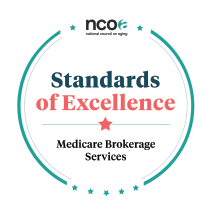Key Takeaways
Medicare is a federal health insurance program for Americans age 65 and older and persons with disabilities that covers a wide range of services to keep you healthy as you age.
There are four parts of Medicare, and it's important to consider plan coverage and prices before you enroll.
There are tools that can help you make some choices based on your personal situation, like NCOA's Age Well Planner.
If you're turning 65, you're eligible to apply for Medicare. But oftentimes, understanding Medicare and the different parts, knowing when to enroll, and even what Medicare covers can seem complicated. That's why we've created this guide to Medicare. It's important to take the time to understand your Medicare plan options, how much it's going to cost you (fact: Medicare is not free), and when you are required to make a decision (fact: Not enrolling on time during your Initial Enrollment Period could lead to a penalty.)
What is Medicare?
Medicare is a federal health insurance program for Americans who are 65 and older that covers a wide range of services to keep you healthy as you age. Some younger people with disabilities, end stage renal disease, and amyotrophic lateral schlerosis (ALS or Lou Gehrig's disease) may also qualify for Medicare. (Learn more about getting Medicare with a disability.)
There are four parts of Medicare, and it's important to consider which coverage is right for you, and how much you may pay for that coverage. If you need help paying for the costs of Medicare, there are programs like Extra Help, the Medicare Savings Programs, Medicaid, and state pharmaceutical assistance programs.
There are tools that can help you make some choices based on your personal situation, like NCOA's Age Well Planner. Start our Medicare Cost Estimator and learn more about your costs, including premiums, copayments, and deductibles. And if you're wondering what benefits you might qualify for to help you pay for health care and medications, NCOA's BenefitsCheckUp can help. In addition, every state has a State Health Insurance Assistance Program to offer free help to people with Medicare and their families to understand their choices.
What are the different parts of Medicare?
Part A: Hospital Insurance
Part A is often called hospital insurance because it pays for care in the hospital. Part A also pays some of the costs of stays at skilled nursing facilities, or health care at home. Finally, Part A also covers hospice care for people who are terminally ill. It is funded by the payroll tax (FICA) that is deposited into the Hospital Insurance Trust Fund.
Part B: Medical Insurance
Part B pays for doctor services, outpatient hospital care, and home health care that Part A does not pay for. It also covers:
- Diagnostic and laboratory tests, such as X-rays and blood work
- Medical equipment, such as wheelchairs and hospital beds
- Orthotics (devices that support joints) and prosthetics (artificial body parts)
- Mental health care
- Ambulance services
- Preventive benefits
Part B is financed by Part B premiums (paid monthly by Medicare beneficiaries) and general revenues from the federal government.
Together, Medicare Parts A and B are sometimes called Original Medicare.
Part C: Medicare Advantage Plans
You can get Medicare coverage either through Original Medicare (Parts A and B) or through a plan sponsored by a private company, called a Medicare Advantage plan. These plans are sometimes called Medicare health plans. If you're enrolled in a Medicare Advantage plan, you'll still have Medicare Parts A and B, but you'll get your health care services through a private plan (that you'll choose). Typically, you will pay the usual Part B premium, plus any additional premium that the plan may charge.
It’s important that anyone considering enrollment into Medicare Advantage weigh the pros and cons to make an informed decision based on the four C’s: coverage, cost, convenience, and choice.
There are different types of Medicare Advantage plans:
- Health Maintenance Organizations (HMOs)
- Preferred Provider Organizations (PPOs)
- Private Fee-for-Service plans (PFFS)
- Special Needs Plans (SNPs)
- Medical Savings Accounts
These plans are required to cover all the same things as Medicare Parts A and B. Most Medicare Advantage plans require people to use providers (like doctors, hospitals, and pharmacies) that are part of their network. Using providers outside a plan’s network will cost more money. These plans also may cover services that Original Medicare does not pay for, like vision or hearing care. These plans also usually cover prescription drugs. Here are some questions you should ask when considering a Medicare Advantage plan.
Part D: Prescription Drug Coverage
Part D helps pay for prescription drugs. Part D is offered by private drug plans who are approved by Medicare. Part D is funded by premiums that you pay for, general revenues from the federal government, and by state payments.
Medicare Supplemental Insurance (Medigap)
Some people may get additional coverage from a current or former employer or union. This employer-sponsored coverage can help to pay for services and costs Medicare does not cover.
Other people may purchase Medicare supplement insurance, known as a Medigap policy. A Medigap insurance policy helps "fill the gaps" in your Original Medicare coverage and is sold by private insurance companies.
There are 11 different standardized Medigap plans that can be sold (try not to be overwhelmed, we have a guide from our Age Well Planner to help you). The cost of a Medigap policy depends on the type of Medigap plan and the company you bought it from. And there are questions you should ask yourself before speaking to insurance representatives about Medigap policies.
How do I get started when I'm ready to apply for Medicare?
Choosing how and when to get Medicare is an important but difficult decision. This choice could determine your health for years to come and save (or cost) you hundreds of dollars in out-of-pocket costs.
There are several different time periods when you can enroll in Medicare and switch or join Medicare Advantage and/or Part D plans. The Open Enrollment Period (OEP) for Medicare happens from October 15th through December 7th every year. During the OEP/Annual Election Period (AEP), you can elect coverage or re-evaluate your Medicare Advantage (MA/Part C) and/or Part D coverage to make sure you’re enrolled in the plan that fits your needs best. Medicare plans change every year, so you should assess how well your plan fits your needs annually.
If you need help sorting through your options, NCOA has a trusted partner that is committed to serving your Medicare selection needs and priorities at no cost to you.
Our process connects you with licensed Medicare enrollment specialists backed by our decades-long commitment to helping older adults thrive. To learn more, connect with an enrollment specialist from Medicare Choice Group today.











